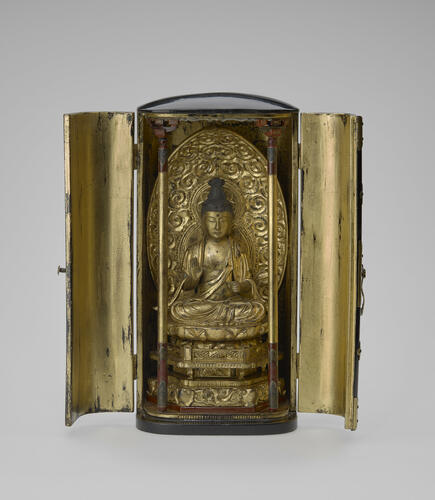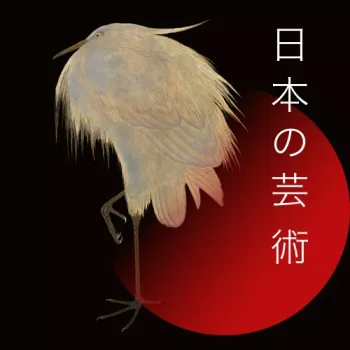Portable shrine (zushi) 1700 - 1800
Wood, black and gold lacquer, gilt bronze | 33.0 x 15.5 x 12.5 cm (whole object) | RCIN 26008
-
Here, a gilt figure of Amida Buddha (Amitabha), the great saviour in Mahayana Buddhism and lord of the Western Paradise, sits cross-legged on a lotus throne. His right hand is raised in abhaya mudra, signifying reassurance and safety, on a multi-tiered base and with a mandorla behind carved with clouds. The plain hinged doors protect the sculpture during travel. Sometimes, the insides of the doors were adorned with polychrome scenes from the Buddhist scriptures or with further Buddhist deities.
This zushi may be the ‘chinese [sic] Deity with Sceptre in a black Japan case folding doors, the inside gilt’ which was sent from the Royal Pavilion, Brighton, to Buckingham Palace in June 1848. If so, it is likely that it was acquired by George IV, whose interest in East Asia extended beyond decorative art to the region’s customs and traditions more broadly. In 1813, for example, he purchased a print of an ‘Indian Idol’, and he acquired specimens of Chinese daily life including musical instruments and tobacco. The zushi may therefore have appealed as much for its expression of Japanese religious practice as for its aesthetic quality.
Buddhism was introduced to Japan from mainland Asia in the sixth century and had a profound impact on all modes of cultural expression, including philosophy, literature and art. During the eighth century, numerous Buddhist temples were built across the country, often on the same sites as Shintō shrines. It was at this time that miniature shrines for private devotion known as zushi also began to appear. Their small scale made them portable as well as suitable for domestic use.Text adapted from Chinese and Japanese Works of Art in the Collection of Her Majesty The Queen: Volume III and Japan: Courts and Culture (2020)
Provenance
Probably acquired by George IV. Reminiscent of an item sent from the Royal Pavilion, Brighton, to Buckingham Palace in June 1848: ‘A chinese Deity with Sceptre in a black Japan case folding doors, the inside gilt’ (1829A, p. 52).
Recorded in the Privy Purse Corridor at Buckingham Palace in 1911 (BP 1911 IX p.268). -
Creator(s)
(place of production)(nationality)Acquirer(s)
-
Medium and techniques
Wood, black and gold lacquer, gilt bronze
Measurements
33.0 x 15.5 x 12.5 cm (whole object)
Category
Object type(s)
Other number(s)
Alternative title(s)
Amida Buddha (Amitabha)
Place of Production
Japan










